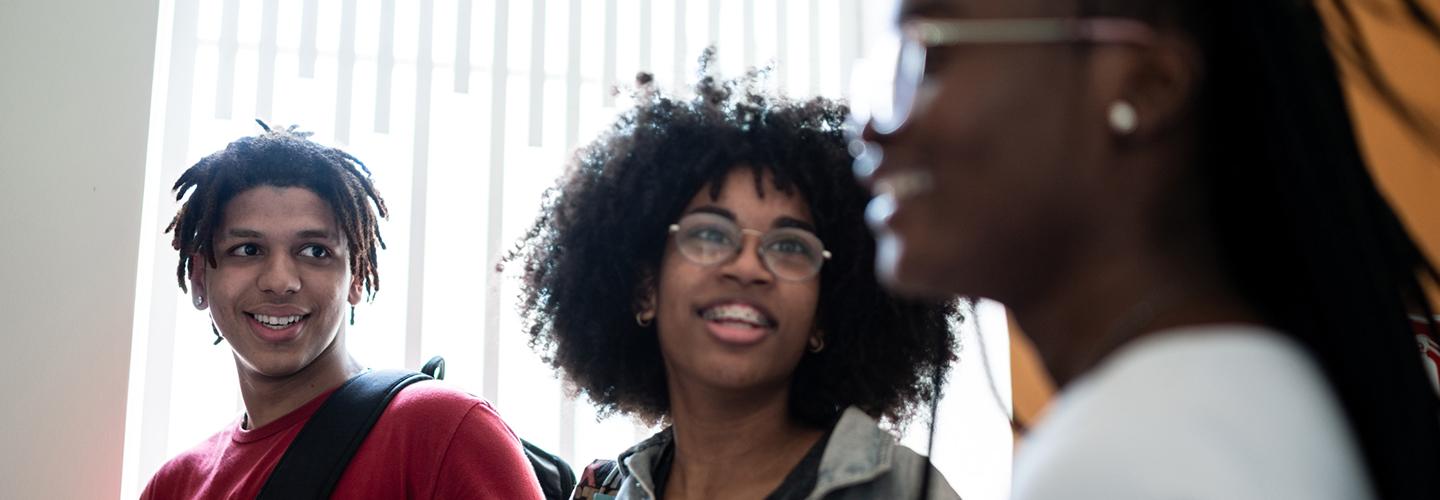Young people in foster care or experiencing homelessness face more hurdles than their peers on the path to high school graduation. While some youth experience both homelessness and foster care, the two groups have important differences and unique needs.
Youth in foster care experience lower high school graduation rates than their peers not in foster care and several factors may inhibit their educational attainment, including school instability, credits not transferring between schools, and a lack of access to supportive adults to help them navigate challenges.[i] Due to systemic bias, Black and Indigenous youth are disproportionately represented in the foster care system and may face additional bias within schools.[ii] Youth who identify as lesbian, gay, bisexual, transgender, or queer/questioning (LGBTQ+) are also overrepresented in the foster care system, often because they are not accepted within their family unit.[iii] LGBTQ+ students have unique experiences in school, which can be exacerbated by their foster care involvement. For example, LGBTQ+ students receive fewer social and developmental supports from teachers and increased rates of bullying.[iv] When LGBTQ+ young people enter foster care they may experience even less support from adults and increased bullying by peers because of their system involvement.[v]
Youth experiencing homelessness also face unique challenges in pursuing their educational goals, such as school and housing instability, high rates of absenteeism, and a lack of access to reliable wireless internet to complete homework.[vi],[vii] Youth experiencing homelessness are a diverse group: Some may experience homelessness with their family unit and others may live on their own rather than with their parents. LGBTQ+ and Black and Hispanic youth are overrepresented in the youth homeless population.[viii] Youth experiencing homelessness may live in a hotel/motel, car, abandoned house, homeless shelter, or on the street; alternately, they may couch surf, live “doubled up” (or sharing a space with other families), or live anywhere else not meant as a permanent dwelling,
While youth in foster care and youth experiencing homelessness both have unique needs as they navigate school, they are also resilient and share many similarities in which supports and services help them succeed and graduate high school. Students in both groups who have access to supportive adults, mentoring, tutoring, and school credit recovery fare better in school than students without access to these services.[ix],[x] However, these services are not provided to all young people in foster care or who are experiencing homelessness. In many schools, students and caregivers are left to navigate the complex education system and child welfare system/homelessness services on their own.
Download
To address this gap and provide needed services to communities throughout California, the National Center for Youth Law (NCYL) runs the Compassionate Education Program (formerly Foster Ed), referred to as Compassionate Ed hereafter. NCYL’s Compassionate Ed initiative aims to improve education outcomes for students who come into contact with public systems, including students in foster care and students experiencing homelessness. Compassionate Ed advances this vision by collaborating with students, family members, community partners, school personnel, and others to deploy four co-occurring strategies, below. This report focuses on Strategy 1.
1. Youth partnership: Engaging with students in a student-centered framework ensures that initiatives center their aspirations, goals, and strengths. Compassionate Ed builds engagement through more intensive connections with students—including weekly (and ongoing) meetings, as well as on an as-needed basis.[xi]
2. Building and supporting positive school culture: Compassionate Ed partners with families (including parents), coaches, teachers, and other supportive adults to increase culturally relevant engagement with students.
3. Systems-level capacity building and training: Compassionate Ed supports more effective implementation of existing laws and policies.[xi]
4. Policy agenda flowing from on-the-ground experiences with youth and community: Compassionate Ed leverages lessons learned with students, family, community, and partners to mobilize local and state policy agendas.[xi]
By implementing Strategy 1, Compassionate Ed serves young people in foster care (Lancaster grades 6-8 and Antelope Valley grades 9-12) or experiencing homelessness (Monterey grades 9-12). At the district level, 20 percent of students in Monterey were experiencing homelessness in the 2021-22 school year and 4 percent of students in Lancaster were in foster care, as were 2 percent of students in Antelope Valley.[xii][xiii],[xiv]
Schools identify students as being in foster care or experiencing homelessness and Compassionate Ed Education Liaisons reach out to those students about the program. The services provided by NCYL’s Education Liaisons are a targeted Tier 3 intervention, which refers to an intervention with the goal of changing outcomes for the students with the greatest need. In addition to being in foster care or experiencing homelessness, students must meet at least one of the additional criteria to be eligible for the program. These additional criteria ensure that NCYL is serving the students with the greatest need:
- Student previously identified as a potential candidate to receive intensive district supports
- Student has one or more behavior referrals in the last four months
- Student is chronically absent
- Student transferred to the district mid-school-year
- Student is school credit deficient
- Student performs below proficiency in math or language arts
- Student has an Individualized Education Plan (IEP) or 504 plan
- Student failed one or more courses in the last school year
Monterey gives additional preference to students who are unaccompanied; to those who live in hotels/motels or shelters, or who are unsheltered (rather than being doubled up or in shared living arrangements); and to 11th and 12th graders.
Compassionate Ed allows students to enroll at different times in their educational careers, based on their needs. For example, a 6th grade student who enters foster care may enroll and remain in the program throughout their time in foster care or through graduating high school. However, another student may not enter foster care until the 10th grade and would become eligible for the program at that point. Regardless of when a student enrolls in Compassionate Ed, once they are enrolled, they are paired with an Education Liaison who works with them to identify education and life goals, build relationships with supportive adults, and ultimately graduate high school.
Download
Footnotes
[i] Courtney, M., Okpych, N. J., Harty, J., Huiling Feng, Park, S., Powers, J., Melanie Nadon, Ditto, D., & Park, K. (2020). Findings from the California youth transitions to adulthood study (CalYOUTH): Conditions of youth at age 23. Chapin Hall at the University of Chicago. https://www.chapinhall.org/research/calyouth-wave4-report/
[ii] Child Welfare Information Gateway. (2021). Child welfare practice to address racial disproportionality and disparity. U.S. Department of Health and Human Services, Administration for Children and Families, Children’s Bureau. https://www.childwelfare.gov/pubs/issue-briefs/racial-disproportionality/
[iii] Youth.gov. (n.d.). Child Welfare. https://youth.gov/youth-topics/lgbtq-youth/child-welfare
[iv] WestEd. (2021). Shedding light on the experiences of LGBTQ students: Sobering data and reasons for hope. https://www.wested.org/wested-bulletin/equity-in-focus/shedding-light-on-the-experiences-of-lgbtq-students-2/
[v] Human Rights Campaign. (n.d.). LGBTQ+ youth in the foster care system. https://www.thehrcfoundation.org/professional-resources/lgbtq-youth-in-the-foster-care-system
[vi] National Center for Homeless Education. (2022). Chronic absenteeism among students experiencing homelessness in America: School years 2016-17 to 2020-21. https://nche.ed.gov/wp-content/uploads/2022/11/Homeless-Student-Absenteeism-in-America-2022.pdf
[vii] VonHoltz, L. A. H., Frasso, R., Golinkoff, J. M., Lozano, A. J., Hanlon, A., & Dowshen, N. (2018). Internet and social media access among youth experiencing momelessness: Mixed-methods study. Journal of Medical Internet Research, 20(5), e9306. https://doi.org/10.2196/jmir.9306
[viii] Gonzalez, S. B., Morton, M., Patel, S., & Samuels, B. (2021). Youth of color disproportionately impacted by housing instability. Chapin Hall at the University of Chicago. https://www.chapinhall.org/research/youth-of-color-disproportionately-impacted-by-housing-instability/
[ix] Dean, S. (2018). Graduation gap: Academic outcomes for students in foster care. Medium. https://spencerdean.medium.com/graduation-gap-academic-outcomes-for-students-in-foster-care-8d69f7abc00c
[x] National Center for Homeless Education. (2017). Supporting the education of unaccompanied students experiencing homelessness (McKinney-Vento Law into Practice Brief Series). https://nche.ed.gov/wp-content/uploads/2018/10/youth.pdf
[xi] National Center for Youth Law. (n.d.). Building compassionate education systems for system-involved students. https://youthlaw.org/initiatives/Building-Compassionate-Systems-Care
[xii] California Department of Education. (n.d.). Monterey Peninsula Unified summary. California School Dashboard. https://www.caschooldashboard.org/reports/27660920000000/2022
[xiii] California Department of Education. (n.d.). Lancaster Elementary summary. California School Dashboard. https://www.caschooldashboard.org/reports/19646670000000/2022
[xiv] California Department of Education. (n.d.). Antelope Valley Union High summary. California School Dashboard. https://www.caschooldashboard.org/reports/19642460000000/2022
Suggested Citation
Rosenberg, R., Ryberg, R., Martinez, M., Surani, K., Rodriguez, Y., Tansey, J., Gabriel, A., & Chandler, T.E. (2023). An evaluation of the National Center for Youth Law’s Compassionate Education program. Child Trends. https://doi.org/10.56417/7307p5208t
Authors
© Copyright 2025 ChildTrendsPrivacy Statement
Newsletter SignupLinkedInYouTubeBlueskyInstagram





